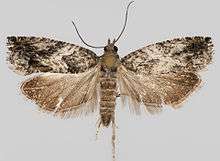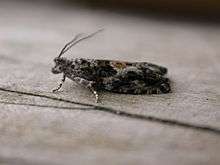Epinotia nisella
Epinotia nisella is a moth of the family Tortricidae which is found in Asia, Europe and North America. It was first described be Carl Alexander Clerck in 1759.
| Epinotia nisella | |
|---|---|
 | |
 | |
| Scientific classification | |
| Kingdom: | |
| Phylum: | |
| Class: | |
| Order: | |
| Family: | |
| Genus: | |
| Species: | E. nisella |
| Binomial name | |
| Epinotia nisella | |
| Synonyms | |
| |
Life cycle
The wingspan is about 12–17 mm. Adults are on wing in July and August and during the day can be found on the foliage or amongst lichen on the tree trunks of the larval foodplants. When disturbed it flies erratically to another resting place and in the evening comes to light.[2] .
Ova
Eggs are laid on poplars (Populus species) and willows (Salix species), especially rough-leaved species.[3] They include aspen (P. tremula), black poplar (P. nigra), grey poplar (Populus × canescens), grey willow (S. cinerea) and goat willow (S. caprea).[2]
Larva
The larvae feed from April to June on the catkins or between a sandwich of two leaves.[a 1]
Pupa
Pupae are light brown and can be found in the larval habitation or in a flimsy, brownish, silken cocoon amongst leaf litter in June and July. Tort book
Distribution
It is found in most of Europe (except Iceland, Portugal, Ukraine and the central part of the Balkan Peninsula), east to the Near East and the eastern part of the Palearctic ecozone. It is also found in North America, including Massachusetts and Minnesota in the United States. In Canada, it is found from Newfoundland to British Columbia.
Notes
- For a description of early and late instars see UKmoths [4]
References
- "Epinotia nisella (Clerck, 1759)". Fauna Europaea. Retrieved 24 December 2018.
- Bradley, J D; Tremewan, W G; Smith, Arthur (1979). British Tortricoid Moths. Tortricidae:Olethreutinae. London: The Ray Society. pp. 109–11. ISBN 0 903874 06 7.
- Emmet, A Maitland (1998). A Field Guide to the Smaller British Lepidoptera (Second ed.). London: The British Entomological and Natural History Society. p. 181. ISBN 0 9502891 6 7.
- Smith, Ian F. "Epinotia nisella". UKmoths. Retrieved 24 December 2018.